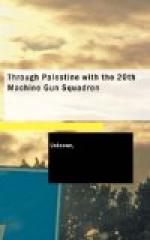As the Brigade marched through the streets on each side there were crowds of people occupied in competing with each other to keep up the most rapid fire! They were none too particular where their shots went either!! It was rather difficult for us to feel pleased to see our new friends, when they were letting off their rifles under our very noses! Fortunately there were no casualties from the spent bullets, but there were several very narrow escapes! The Turk, it seemed, had fled two days previously, and left at the aerodrome the remains of no fewer than 30 aeroplanes which he had burnt, together with large quantities of stores and rolling stock.[36]
An outpost line was established at Hosh el Ghanin, and “No. 1” Section returned to the Squadron, which had encamped to the east of the town south of the village of Maazi. October 7th-12th were spent in grazing, cleaning up and resting (not much of the last). On Oct. 10th, the 13th and 14th Brigades had moved on four miles to Tel esh Sherif, the 15th Brigade being at Zahle, a fair-sized town on the slopes of the hills on the western side of the plain.[37]
At this time enemy aeroplanes began to arrive, and drop bombs, killing, on one occasion, some Gloucesters. A few days afterwards they were chased to their lair by the R.A.F. and—finished off!
FOOTNOTES:
[35] After the massacre
of 1860, Lebanon was made an independent
province, governed by a Christian
Pasha, nominated by the Sultan of
Turkey and approved by the
European Powers.
[36] Rayak is the junction
of the railway from Beirut to Damascus and
Aleppo to Damascus.
[37] Zahle is the largest
town in Lebanon, and has a population of
about 16,000, nearly all of
whom are Christians. During the massacre of
1860, it suffered terribly,
being captured and burnt to the ground.
THE JOURNEY TO HOMS.
The 14th Brigade, following the 13th Brigade one day’s march behind, moved up to Baalbek on October 13th. Here we ascertained that the leading brigade had had a similar reception to ours from the natives at Rayak. Passing through the town and the ruins of the celebrated Roman Temple of the Sun[38] on the left, we camped east of the Turkish barracks.
North of Baalbek our maps were found to be very inaccurate and unreliable, the actual position of places often proving to be many miles away from where shown; frequently roads followed quite a different route! In one place a railway line was omitted altogether from the map, while in another, a river marked thereon did not exist!
Rations, now being brought up by motor lorries nearly every day, were issued to units as soon as they had camped for the night; mutton was the principal meat ration, sheep being requisitioned locally, all along the route, as also was forage.




